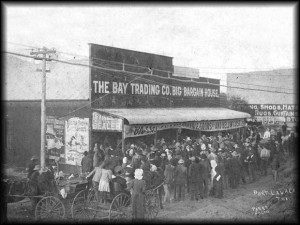LINNVILLE
Three and a half miles from Port Lavaca is a field that used to be a thriving center of commerce. The town of New Port or Linnville had a population close to 200 around 1839. It was started by John Linn in 1831 as a warehouse center for the importation of goods. The town had warehouses, piers, a hotel, stores, a customs house and a doctor as well as a residential area.
In 1840, Comanche Indians destroyed the town during, The Great Comanche Raid. On August 8, the Comanche Indians raided Linnville and burned the town. Most of the townspeople escaped, by small boats, into the bay. Some were saved on the steamship, Mustang. As the residents looked back at the shore, they saw their homes and businesses being destroyed.
The raiders tied red cloth to the tails of their horses and rode around waving umbrellas and wearing clothes and other items taken from the various shops. They continued the raid all day. Some of the town’s inhabitants were killed, including Hugh Watts, the customs collector. Major Watts’ wife, of only a few months, was kidnapped with another woman and her child. Juliet Watts survived her kidnapping although she was shot with an arrow. The steel in her corset, a tight fitting undergarment, saved her life. The other woman and her child were not as lucky and lost their lives. Mrs. Watts eventually moved to Lavaca (Port Lavaca) and married a man named Stanton and later she married Dr. Fretwell. You can see Major Watts’ grave marker at the Ranger Cemetery on Harbor Street.
PORT LAVACA
After the 1840 raid on Linnville, most of the residents moved to the smaller town of Lavaca. By 1846, when Calhoun County was established, Lavaca had become the county seat. It was originally named Port of La Vaca or Port of the Cow.
Lavaca had seven wharves. Some of the items they shipped out were cotton, wool, the hooves, hides and horns of beef, tallow, pecans, and copper, as well as lead and silver from Mexico. This was a period of great growth for the town.
In 1856, the San Antonio Mexican Gulf Railroad started laying its rails and the line opened in 1857. This connected Port Lavaca with Victoria. North of Lavaca, the Indianola railroad joined this line at Clark’s Station.
As the size of Indianola grew, Lavaca tried to keep its place as the main port and the county seat but in 1852 Indianola took that away from Lavaca. Most of the shipping moved to Indianola as well.
In 1862, during the Civil War, Northern gunboats attacked Lavaca. It was defended by two waterfront units and managed to make the Federal ships turn back. A man named E. C. Singer created some of the first underwater contact mines for the Confederacy. He owned a foundry on Lavaca Bay. He created the “Singer Secret Service Corps,” known as the “Singer Submarine Corps” and the “Singer’s Torpedo Company.” He is known as the man who helped to create the Confederate submarine, the Hunley, in Charleston, South Carolina. They used Singer’s torpedo to blow up the USS Housatonic before the submarine sank with all hands. Federal troops occupied Lavaca in December 1863. Lavaca lost its wharves and its railroad during the war leading to Indianola becoming the more important town and county seat.
Later, following the 1886 hurricane that destroyed Indianola, Port Lavaca became the county seat once more and still is today. It was officially named Port Lavaca in 1879.
